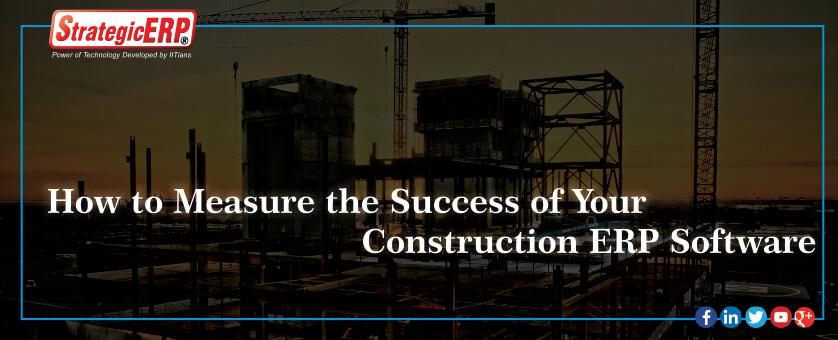How to measure success of your construction
Category :
Blog posted by : Admin / 17 Aug, 2018
How to Measure the Success of Your Construction ERP Software
After closely analyzing how ERP software can empower your construction business, you embarked on your implementation journey. You had already heard time and again, from industry experts and peer companies alike, how an ERP implementation can bring in immense productivity and efficiency benefits for your construction business. However, if you are one of the many firms, the chances are you might be wondering has the construction ERP software implementation delivered to its promise. For most firms, the only method of measuring construction ERP post-implementation success is cost saving and revenue increase. Although thats definitely important, there are other important points that need to be considered for clearly understanding if your construction ERP system implementation is a hit or miss.
Here are some evaluation criteria that will help you measure the success of your construction ERP:
1. Look Out for Initial Visible Indicators: A great place to begin your post-implementation evaluation is looking for smoothness in working on construction ERP solution. If the system is up and running without severely impacting operations, it is a tell-tale sign of the initial success of the ERP for construction. Keep a close eye on system downtimes—the lesser the number, the better is the performance of the solution. Also, analyze whether the implementation happened in scheduled time and estimated budget. Its a great idea to check earned value (value of the work actually completed to date) against the actual cost of the project in ERP software. If the earned value matches or goes above the actual cost, then it is a clear indication that ERP software has been successful throughout the project.
2. General Acceptance: One of the great metrics to check the success of your construction ERP implementation is its internal usage and overall employee engagement. For example, check if employees are readily using features like instant messaging in ERP and mobile apps for enhancing communication and coordination between departments. Seek answers for questions like: Has the construction ERP solution become a part of day-to-day operations? Has it completely replaced the older system? Are employees finding it easier to use and rate it more efficient than the legacy system? If the answers to the above questions are affirmative, then its a clear indication that the construction ERP software is working for you.
3. Check the Impact on Key Business Requirements: For the post-implementation evaluation, go back and analyze the prime factors that prompted your construction business to adopt the ERP solution. Has the construction ERP software addressed the issue of departments operating in silos? Do you notice increased intradepartmental collaboration and increased efficiency? Has the ERP become a single source of data, completely eliminating the manual processes of entry? Is the construction ERP solution giving you a 360-degree visibility into the ongoing projects progress? For instance, check the cash flow statement. Analyze if you are getting data on payments and receipts month wise, which are then helping you to find out surplus and deficit for the particular period of time. If you are seeing results in such key business areas, then your ERP implementation is on the right track. You can then keep evolving the ERP for construction for added benefits.
4. Check Out for Improved Decision Making: A great advantage of ERP systems for the top leadership is quick access to reports and dashboards, which greatly enhance decision-making abilities. Analyze if the construction ERP system has empowered you to access business-critical data at the click of a button. Is the information available enabling you to plan better and stick to the timelines and budget estimates? If yes, then it definitely determines the success of your construction ERP solution. For instance, look out if you can readily access details like fund availability and outstanding receivable to help you meet the current project cost needs like inventory buying, raw materials requirement, wages, etc.
Once you do your post-go-live analysis, it is important that you dont treat the result as a single instance. Its a great idea to keep reviewing the impact every three months and you should keep seeing an upward trend. If you are working with a good construction ERP provider that has a strong management team, you would notice incremental benefits every time. However, if these important metrics are not as per your expectation, then you need to resolve the possible glitches or look at training requirements.







